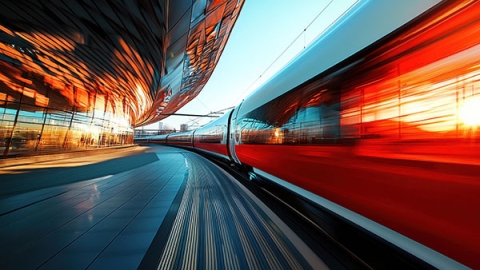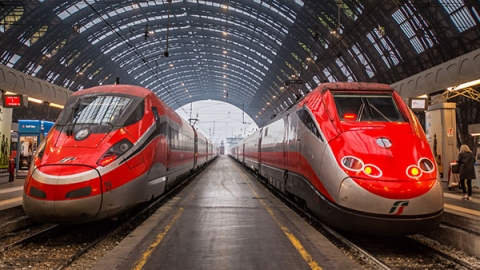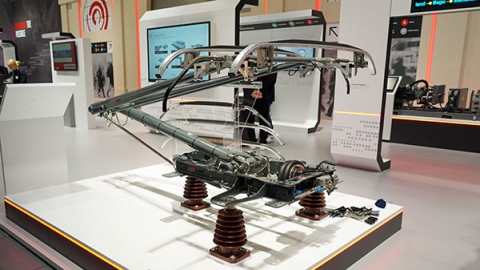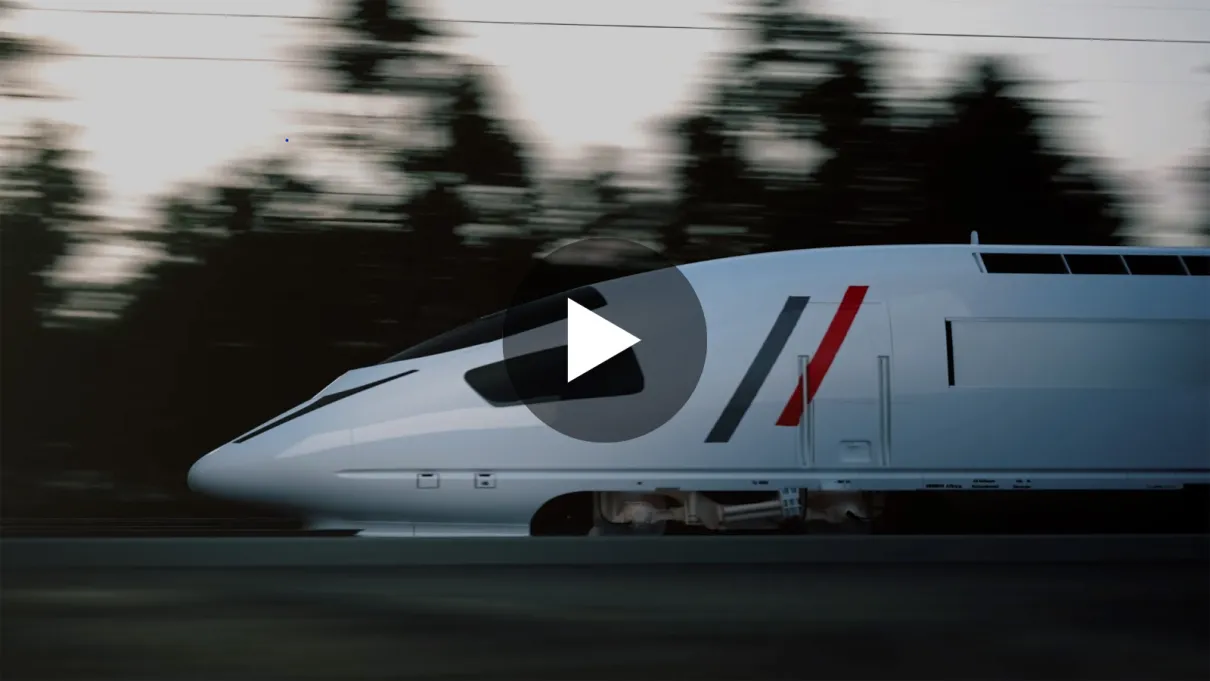There Are High-Speed Trains, Then There Are Very-High-Speed Trains
With a Product Portfolio Built for Speed, Wabtec Excels at Both
Introduction
In the five minutes or so that it takes to read this article, a very-high-speed (VHS) train somewhere in Japan or Europe will have traveled at least ~25 kilometers1. In China, even farther. That’s because VHS trains, those that travel 250+ kilometers per hour (kph), or 155+ miles per hour (mph), go really fast.
And today 250 kph is barely scratching the surface.
VHS trains around the world, from Europe (UK, France, Germany, Italy, Spain) to Asia (Japan and China) are pushing the envelope on speed, with China currently testing a train intended for commercial service at 450 kph!
Wherever train speed records fall, and, more importantly, get adopted into commercial service, Wabtec innovation will be found in full flower. Wabtec is literally all over VHS trains, from front to back and top to bottom, providing the leading pantographs and brake, door and HVAC systems that continue to meet the multiple mandates of high speed rail:
- Safety – With no room for error, VHS requires precision design.
- Aerodynamics – Think mind- and metal-bending pressures.
- Comfort – Passengers don’t want to hear or feel those pressures
- Cost – The cost of innovation can’t push ticket prices out of reach.
And while all modes of train travel involve some of these same mandates, put simply, very high speed is a force multiplier.
“Don’t forget,” reminds Paolo Pagliero, Vice President of Transit Engineering at Wabtec, “aerodynamic resistance increases parabolically with velocity, so that a doubling of kph increases resistance by 4x. The aerodynamic forces working against VHS trains at top speed are almost unimaginable, as are the pressures in play when such trains enter tunnels or pass each other in close proximity.”
If this all sounds challenging, it should come as no surprise that Wabtec is on the front lines of this complex design and manufacturing frontier.
VHS rail, a growing and dynamic market
Interest today in VHS rail is high, extending from nascent markets as diverse as the U.S. and India to trailblazers across Europe and Asia. The European Commission for instance has plans to double high-speed rail passenger traffic by 2030, and triple it by 2050.

These ambitious goals require not only ongoing design innovation, i.e., building faster trains that also provide a passenger experience comparable to – and competitive with – air travel, but additionally rail transit networks, i.e., “infrastructure,” built for speed. Currently, the latter is the bigger bottleneck – at least in Europe.
Adds Pagliero, “Europe today has something akin to an ‘air traffic control’ problem on its high-speed rail lines. In many countries, high-speed and very-high-speed trains share the same tracks with slower regional trains, which means these faster trains have to run sub-optimally. The same goes for high speed trains running routes with frequent stops. Once you consider the time and energy it takes for a train to reach and run at full speed – and the time and distance required to stop it – VHS trains often by necessity must operate at lower speeds.”
Despite these hurdles, demand for VHS trains remains strong, with many operators hedging their bets that their VHS trains eventually will spend more time traveling at the speeds for which they were designed.
“Remember, rail operators view new train purchases as 40-year investments, so even if their lines aren’t currently optimized for very high speed travel, they often want to ensure that they’ll have trains capable of delivering that experience once the infrastructure, both in-country, and, in the case of Europe, cross-border, evolves accordingly,” offers Pagliero.
Building out VHS rail networks will ultimately require a massive infrastructure investment, from building new tunnels under major rail hubs, to architecting new lines optimized solely for very high speeds.
“Threading high speed lines through relatively densely populated countries is a tricky business,” observes Chris Jackson, Senior Editor, Railway Gazette Group. “Success ultimately hinges on strong political backing. Unless there is the political will to say, ‘we want this to happen,’ it’s not going to happen.”
Pantographs and more for HS2
Such is the case in the United Kingdom, where the High Speed Two (HS2) rail project is looking to usher millions of passengers on a 225 km (140 m) route between Birmingham and London at routine speeds of 330 kph (205 mph) and peak speeds of 360 kph (220 mph). While the rail network is still under construction, HS2 officials have already awarded a contract to a consortium of Hitachi-Alstom to design and build 54 electric high-speed trains for the new railway.

In turn, that consortium has selected Wabtec to provide the new train’s pantograph, brakes, and doors.
“Hitachi-Alstom is in the process of designing new trains for HS2 based on the successful ETR1000 model, which runs on Italy and Spain’s high-speed networks and can reach top speeds of 400 kph,” says Pagliero. “Wabtec’s experience providing key components for the ETR1000 is extensive, which led to our selection for the HS2 project.”
Because the new Hitachi-Alstom trains are being custom-built for HS2, Wabtec will be developing a brand new pantograph design for the project, adding to the more than 150 pantograph models it currently has in operation on over 90,000 trains worldwide.
“Pantograph innovation at Wabtec is second to none,” says Adam Hajek, Pantograph Systems Engineering Leader, Power Collection at Wabtec, “especially at high speeds, where Wabtec pantographs have enabled trains to set world speed records dating back to 1955, and more recently in 1990 and 2007, where we helped achieve record speeds of 515 kph and 574 kph, respectively.”

Adds Philippe Geoffroy, Pantograph Product Development Leader, Power Collection at Wabtec, “The new pantographs for the HS2 project will provide us with an opportunity to highlight the agility of our design approach. We’re designing for a completely new train, which means a completely new rooftop, and with it a challenging new integration. Meeting this kind of challenge requires a ‘co-design’ approach, a close collaboration with our customer Hitachi-Alstom. When you want to reduce the aerodynamic loss of a pantograph on a never-before-designed rooftop for a VHS train, you can’t do it alone.”
Similarly, Wabtec is innovating its way through design challenges for the doors of the new VHS HS2 trains.
“Innovation isn’t always about reinventing the wheel: it’s about knowing how to apply proven technologies to new challenges,” explains Nicolas Mangeol, Doors Engineering Director at Wabtec. “For HS2, we’re adapting our service-proven, high-performance inflatable seal to meet the typical aerodynamic shocks of high-speed operations.
“As a passenger, you may have experienced it: loud noise or the feeling of pressure in your ears when passing through a tunnel or crossing another train. The inflatable seal ensures optimal airtightness, which reduces noise and prevents sudden pressure variations that can cause passenger discomfort. This is just one of our door system’s many characteristics that make it a key enabler of both safety and comfort at very high speeds.”
VHS innovation is a team sport
Whether innovating collaboratively with a customer, as it is doing with Hitachi-Alstom on pantographs for HS2, or ‘going it alone’ in its own design hubs in Tours, France; Piossasco and Avellino, Italy; or Leipzig, Germany, Wabtec’s track record of high-speed innovation is hard to beat.
For example, in developing the brake system for the ETR1000, Wabtec performed extensive testing that simulated emergency stops at high speed. During the tests, the Wabtec disc brakes reached a scalding 900° F (480°C) and continued to operate flawlessly. Such thorough testing, and the resilience to harsh conditions Wabtec designs into all its products, including those for VHS trains, helps avert catastrophes and save lives.
“Everything is extreme when you run at such high speed,” concludes Pagliero.
Not coincidentally, such commitment to operating – and innovating – at these extremes also landed Wabtec the brake systems contract for HS2.
Winning around the world
Speaking of extremes, the undisputed new frontier for high-speed train travel is China. Remember the infrastructure bottlenecks throttling down speeds on the Continent? China, for the most part, doesn’t have them.
The country has built out the Beijing-Shanghai high-speed railway that readily supports travel at 350-360 kph and, as mentioned earlier, is testing a next generation of VHS train for commercial service at 450 kph. There are even whispers of a 600 kph train in early development, but that’s a story for another time.
The story for now is that wherever VHS train travel is happening or being discussed, Wabtec is actively innovating to turn very high speed dreams into safe, comfortable, and compelling commercial realities. And it has the contracts to prove it – all around the world.
1 Assuming a speed of 300 kph.
